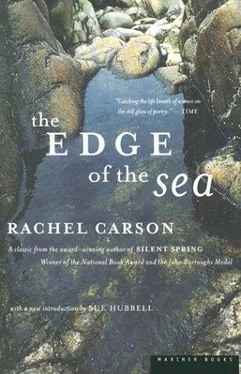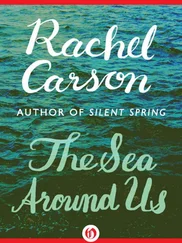Rachel Carson - The Edge of the Sea
Здесь есть возможность читать онлайн «Rachel Carson - The Edge of the Sea» весь текст электронной книги совершенно бесплатно (целиком полную версию без сокращений). В некоторых случаях можно слушать аудио, скачать через торрент в формате fb2 и присутствует краткое содержание. Город: Boston, Год выпуска: 1998, ISBN: 1998, Издательство: Mariner Books, Жанр: Биология, sci_ecology, sci_popular, на английском языке. Описание произведения, (предисловие) а так же отзывы посетителей доступны на портале библиотеки ЛибКат.
- Название:The Edge of the Sea
- Автор:
- Издательство:Mariner Books
- Жанр:
- Год:1998
- Город:Boston
- ISBN:978-0-395-07505-0
- Рейтинг книги:4 / 5. Голосов: 1
-
Избранное:Добавить в избранное
- Отзывы:
-
Ваша оценка:
- 80
- 1
- 2
- 3
- 4
- 5
The Edge of the Sea: краткое содержание, описание и аннотация
Предлагаем к чтению аннотацию, описание, краткое содержание или предисловие (зависит от того, что написал сам автор книги «The Edge of the Sea»). Если вы не нашли необходимую информацию о книге — напишите в комментариях, мы постараемся отыскать её.
A book to be read for pleasure as well as a practical identification guide,
introduces a world of teeming life where the sea meets the land. A new generation of readers is discovering why Rachel Carson’s books have become cornerstones of the environmental and conservation movements. New introduction by Sue Hubbell.
The Edge of the Sea — читать онлайн бесплатно полную книгу (весь текст) целиком
Ниже представлен текст книги, разбитый по страницам. Система сохранения места последней прочитанной страницы, позволяет с удобством читать онлайн бесплатно книгу «The Edge of the Sea», без необходимости каждый раз заново искать на чём Вы остановились. Поставьте закладку, и сможете в любой момент перейти на страницу, на которой закончили чтение.
Интервал:
Закладка:
Again the physical facts of the American Atlantic coast are such that the observer of its life has spread before him, almost with the clarity of a well-conceived scientific experiment, a demonstration of the modifying effect of tides, surf, and currents. It happens that the northern rocks, where life is lived openly, lie in the region of some of the strongest tides of the world, those within the area of the Bay of Fundy. Here the zones of life created by the tides have the simple graphic force of a diagram. The tidal zones being obscured on sandy shores, one is free there to observe the effect of the surf. Neither strong tides nor heavy surf visits the southern tip of Florida. Here is a typical coral coast, built by the coral animals and the mangroves that multiply and spread in the calm, warm waters—a world whose inhabitants have drifted there on ocean currents from the West Indies, duplicating the strange tropical fauna of that region.
And over all these patterns there are others created by the sea water itself—bringing or withholding food, carrying substances of powerful chemical nature that, for good or ill, affect the lives of all they touch. Nowhere on the shore is the relation of a creature to its surroundings a matter of a single cause and effect; each living thing is bound to its world by many threads, weaving the intricate design of the fabric of life.

The problem of breaking waves need not be faced by inhabitants of the open ocean, for they can sink into deep water to avoid rough seas. An animal or plant of the shore has no such means of escape. The surf releases all its tremendous energy as it breaks against the shore, sometimes delivering blows of almost incredible violence. Exposed coasts of Great Britain and other eastern Atlantic islands receive some of the most violent surf in the world, created by winds that sweep across the whole expanse of ocean. It sometimes strikes with a force of two tons to the square foot. The American Atlantic coast, being a sheltered shore, receives no such surf, yet even here the waves of winter storms or of summer hurricanes have enormous size and destructive power. The island of Monhegan on the coast of Maine lies unprotected in the path of such storms and receives their waves on its steep seaward-facing cliffs. In a violent storm the spray from breaking waves is thrown over the crest of White Head, about 100 feet above the sea. In some storms the green water of actual waves sweeps over a lower cliff known as Gull Rock. It is about 60 feet high.
The effect of waves is felt on the bottom a considerable distance offshore. Lobster traps set in water nearly 200 feet deep often are shifted about or have stones carried into them. But the critical problem, of course, is the one that exists on or very close to the shore, where waves are breaking. Very few coasts have completely defeated the attempts of living things to gain a foothold. Beaches are apt to be barren if they are composed of loose coarse sand that shifts in the surf and then dries quickly when the tide falls. Others, of firm sand, though they may look barren, actually sustain a rich fauna in their deeper layers. A beach composed of many cobblestones that grind against each other in the surf is an impossible home for most creatures. But the shore formed of rocky cliffs and ledges, unless the surf be of extraordinary force, is host to a large and abundant fauna and flora.
Barnacles are perhaps the best example of successful inhabitants of the surf zone. Limpets do almost as well, and so do the small rock periwinkles. The coarse brown seaweeds called wracks or rockweeds possess species that thrive in moderately heavy surf, while others require a degree of protection. After a little experience one can learn to judge the exposure of any shore merely by identifying its fauna and flora. If, for example, there is a broad area covered by the knotted wrack—a long and slender weed that lies like a tangled mass of cordage when the tide is out—if this predominates, we know the shore is a moderately protected one, seldom visited by heavy surf. If, however, there is little or none of the knotted wrack but instead a zone covered by a rockweed of much shorter stature, branching repeatedly, its fronds flattened and tapering at the ends, then we sense more keenly the presence of the open sea and the crushing power of its surf. For the forked wrack and other members of a community of low-growing seaweeds with strong and elastic tissues are sure indicators of an exposed coast and can thrive in seas the knotted wrack cannot endure. And if, on still another shore, there is little vegetation of any sort, but instead only a rock zone whitened by a living snow of barnacles-thousands upon thousands of them raising their sharp-pointed cones to the smother of the surf—we may be sure this coast is quite unprotected from the force of the sea.
The barnacle has two advantages that allow it to succeed where almost all other life fails to survive. Its low conical shape deflects the force of the waves and sends the water rolling off harmlessly. The whole base of the cone, moreover, is fixed to the rock with natural cement of extraordinary strength; to remove it one has to use a sharp-bladed knife. And so those twin dangers of the surf zone—the threat of being washed away and of being crushed—have little reality for the barnacle. Yet its existence in such a place takes on a touch of the miraculous when we remember this fact: it was not the adult creature, whose shape and firmly cemented base are precise adaptations to the surf, that gained a foothold here; it was the larva. In the turbulence of heavy seas, the delicate larva had to choose its spot on the wave-washed rocks, to settle there, and somehow not be washed away during those critical hours while its tissues were being reorganized in their transformation to the adult form, while the cement was extruded and hardened, and the shell plates grew up about the soft body. To accomplish all this in heavy surf seems to me a far more difficult thing than is required of the spore of a rockweed; yet the fact remains that the barnacles can colonize exposed rocks where the weeds are unable to gain a footing.
The streamlined form has been adopted and even improved upon by other creatures, some of whom have omitted the permanent attachment to the rocks. The limpet is one of these—a simple and primitive snail that wears above its tissues a shell like the hat of a Chinese coolie. From this smoothly sloping cone the surf rolls away harmlessly; indeed, the blows of falling water only press down more firmly the suction cup of fleshy tissue beneath the shell, strengthening its grip on the rock.
Still other creatures, while retaining a smoothly rounded contour, put out anchor lines to hold their places on the rocks. Such a device is used by the mussels, whose numbers in even a limited area may be almost astronomical. The shells of each animal are bound to the rock by a series of tough threads, each of shining silken appearance. The threads are a kind of natural silk, spun by a gland in the foot. These anchor lines extend out in all directions; if some are broken, the others hold while the damaged lines are being replaced. But most of the threads are directed forward and in the pounding of storm surf the mussel tends to swing around and head into the seas, taking them on the narrow “prow” and so minimizing their force.
Even the sea urchins can anchor themselves firmly in moderately strong surf. Their slender tube feet, each equipped with a suction disc at its tip, are thrust out in all directions. I have marveled at the green urchins on a Maine shore, clinging to the exposed rock at low water of spring tides, where the beautiful coralline algae spread a rose-colored crust beneath the shining green of their bodies. At that place the bottom slopes away steeply and when the waves at low tide break on the crest of the slope, they drain back to the sea with a strong rush of water. Yet as each wave recedes, the urchins remain on their accustomed stations, undisturbed.
Читать дальшеИнтервал:
Закладка:
Похожие книги на «The Edge of the Sea»
Представляем Вашему вниманию похожие книги на «The Edge of the Sea» списком для выбора. Мы отобрали схожую по названию и смыслу литературу в надежде предоставить читателям больше вариантов отыскать новые, интересные, ещё непрочитанные произведения.
Обсуждение, отзывы о книге «The Edge of the Sea» и просто собственные мнения читателей. Оставьте ваши комментарии, напишите, что Вы думаете о произведении, его смысле или главных героях. Укажите что конкретно понравилось, а что нет, и почему Вы так считаете.












